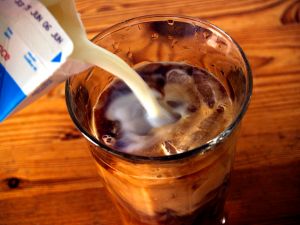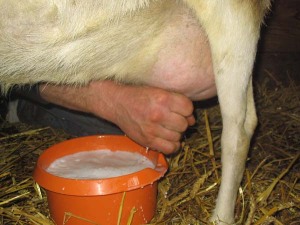by Helen Shen
How dangerous is unpasteurized milk? Many health-conscious consumers want to know. The answer depends on how you look at the numbers.
In March, CDC scientists published a study in the journal Emerging Infectious Diseases that tried to quantify this risk by analyzing milk-related disease outbreaks from 1993 to 2006.
The research was widely covered in the mainstream news media, including in a story I wrote for the San Jose Mercury News. The study also attracted a fair amount of online outrage from many raw milk enthusiasts, who treated it as a piece of biased government propaganda.
The CDC media press release, several news stories, and the research paper itself highlighted two main points: first, that 75 percent of raw milk outbreaks occurred in states where raw milk was legal at the time (in an interview with me, first author Adam Langer called this “the most important result of the study”); and second, that raw milk is 150 times more dangerous than pasteurized milk.
Plenty of aspects of the raw milk debate are unscientific. Food choices are personal, cultural, and political. Twelve states allow retail sales of raw milk. Twenty states ban raw milk sales outright. The remaining states allow only limited raw milk sales, such as on-farm transactions.
Unfortunately, emphasizing those particular research findings may have hindered a truly scientific discussion about raw milk risks.
Proving the obvious
Let’s think about the first conclusion. Between 1993 and 2006, raw milk caused more outbreaks in states where the unpasteurized product was legal. Is that like saying car accidents happen more often on roads that permit cars?
Langer told me, “It is not necessarily surprising. We do occasionally have to do scientific studies in order to prove what one would think would be obvious. But it is important evidence to show that laws that restrict the sale of unpasteurized dairy products are very important public health tools to reduce the number of outbreaks that are caused by these products.”
Basically, the study suggests that in states that ban raw milk sales, few people consume and get sick from black market raw milk, says Michele Jay-Russell, a food safety expert at UC Davis and a former scientist with the California Department of Public Health.
Hm. That’s probably good news, but it doesn’t offer any real information about how risky raw milk actually might be. That’s where the second point could help.
Outbreaks versus individuals
The authors concluded that raw milk carries 150 times greater risk than pasteurized milk of causing disease outbreaks. (A disease outbreak is a cluster of illnesses thought to originate from the same source. It could involve 2, 200, or 2,000 people.)
Here’s some of the math: Only about 1 percent of the population is thought to consume raw milk. Assuming they consume milk in roughly the same quantities as other milk drinkers, and assuming the two types of milk were equally safe, you’d expect about 1 percent of outbreaks to be related to raw milk. Instead, the CDC found 60 percent of outbreaks—150 times more than expected—were linked to raw milk.But what happens if, instead of using outbreaks, you look at those individuals involved in milk-related outbreaks? Those numbers tell a slightly different story.
In total, raw milk outbreaks sickened 1571 people. Pasteurized milk sickened 2842. So, while raw milk was implicated in 60 percent of outbreaks, it accounted for only 35 percent of all outbreak-sickened individuals. Thirty-five percent is still 55 times more than you’d expect to see from the small fraction of milk drinkers who consume unpasteurized dairy. That’s cause for concern, but it’s a much smaller effect than if you measure risk by outbreaks.
The average reader doesn’t think in terms of disease clusters, but is interested in individual risk. Health agencies, on the other hand, get concerned and become involved when outbreaks occur, says Jay-Russell.
“If you’re part of an outbreak, or if you’re the only one that got sick, it’s all the same ‘badness’ for you personally. From a public health resource standpoint, having these dozens of outbreaks, every one of those requires stopping work on other public health issues,” she said.
The authors didn’t communicate the reasons for their choice—non-intuitive for the general public—for calculating outbreak statistics in their paper. Nor did they include the relative risk statistics for individuals. Doing so could have helped their case.
But because the omitted statistics would have produced a weaker result, the authors invited criticisms of manipulating the numbers to their advantage.
In a press release entitled “CDC Cherry Picks Data to Make Case Against Raw Milk,” the pro-milk non-profit Weston A. Price Foundation said, “Perhaps most troubling is the authors’ decision to focus on outbreaks rather than illnesses… In addressing the risk posed for individuals who consume a food, the logical data to examine is the number of illnesses, not the number of outbreaks.”
Distracting from the data
Jay-Russell says she’s more concerned that young people and children are disproportionately sickened by raw milk—a finding that received relatively less attention. The CDC study found that 60 percent of individuals sickened by raw milk outbreaks were younger than 20. That number contrasts with 23 percent for pasteurized milk outbreaks.
Even though a small fraction of the population drinks raw milk, the majority of those sickened in raw milk outbreaks are young. This effect is partly explained by the fact that raw milk is touted by its fans as a health food—not just acceptable for children, but especially beneficial to their growth and well-being.
In my next blog post, I’ll examine some of these health claims.



Leave a comment